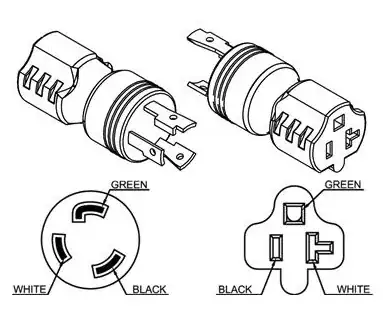You are safe.
All you're taking about doing is plugging a 120V device into a 120V circuit, using a plug adapter you can purchase off the shelf.
For anything beyond this, consult a local licensed electrician.
If this wasn't safe, you couldn't just buy the adapters off the shelf. But you can buy these kinds of adapters:
Your UPS isn't going to draw any more current through a 30A breaker than it does through a 15A or 20A breaker.
All of your circuit breakers are clamped directly onto the fat aluminum buses in your service panel and subpanel(s), which are in turn directly connected to the fat cables that connect directly to the windings on the step-down transformer coil on the pole outside your home or office.
All the devices you plug into the wall, from a tiny 5 watt light bulb to your phone charger to your dishwasher, are directly connected to that transformer outside (which is directly connected to the high voltage power distribution grid).
Essentially all your circuit breakers (or fuses) do is protect the wires downstream from them, by cutting the power when more current passes through them than the wires can carry without getting too hot. Have you ever noticed how thin the high voltage wires on power poles seem to be? They are air-cooled, not closed up inside walls in buildings. Circuit breakers are there to prevent fires. When current gets too high, electrical resistance in the wire increases, the wire gets hot, potentially extremely hot, and buildings burn down.
But again, the breaker doesn't affect how much current a device draws. It just cuts the circuit if the cumulative load passing through the breaker is more than the wire is rated to handle. You have a 30A breaker, in this case, protecting #10 wires, so barring some kind of equipment failure you're not going to have a fire.
And you won't damage your UPS, either, because, the voltage potential on that circuit is 120V, which is exactly what the UPS is designed for. It's only going to pull as much current (Amps) as it's designed for, and also has its own internal overload protection (it's UL listed, right?). You could attach it directly to the bus bars in your service panel and it would function without burning up (not advised for all kinds of other reasons, of course).
The breakers (or fuses) do not modify the power in any way, except possibly through a tiny bit of voltage loss to thermal inefficiency (like how an old incandescent light bulb uses more energy producing heat than it does producing light). The step-down transformer on the pole outside is where the power is modified. That's why you get 120 Volts in your outlets instead of the 17,000 Volts that is energizing the local distribution lines.
GFCI and arc-interrupt breakers don't modify the power that passes through them, either. They just detect and trip the circuit under additional conditions:
GFCI trips the circuit when a sudden voltage imbalance appears between the hot and neutral legs of the circuit, indicating that the juice found an alternative path to ground, which may well be straight through a human being. So GFCI protects against electrocution rather than protecting against fire.
Arc interruption breakers detect when an electrical arc occurs somewhere on the circuit and cut power. Electrical arcs start fires. Arc interrupt breakers are also a pain because they'll cut circuits when you do things like unplug your vacuum cleaner and a little arc occurs inside the wall receptacle as the prongs on the vacuum cleaner's plug break contact with the prongs inside the receptacle. But the electrical code requires them in many instances now.
Caveats:
DO NOT do something like jerry-rig a 120V receptable somewhere downstream on a 240V circuit (the 240V circuit will have 2 120V hot conductors, a ground and usually a neutral unless it is a very old circuit). That neutral wire (or the ground wire if it's an old hot/hot/ground circuit) carries the imbalance of the load between the hot conductors and you don't want to go around intentionally creating imbalanced circuits, and I'm pretty sure the N.E.C. says this is illegal. (EDIT: Actually, a 230/240V circuit will be a little different depending on whether the incoming service is single phase ("Edison") or 3-phase, but this explanation is probably close enough.)
Also, if you have a noisy load like a big motor on that same 30A circuit, it could potentially impact your sensitive electronics (although your UPS might mitigate that, but you could also potentially shorten the life of your UPS).
